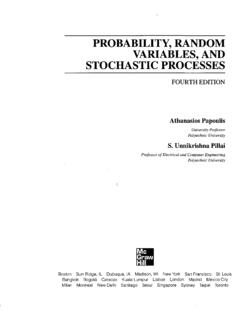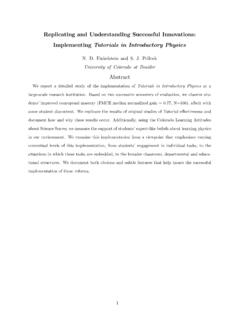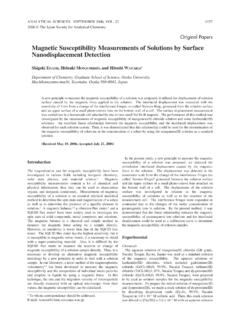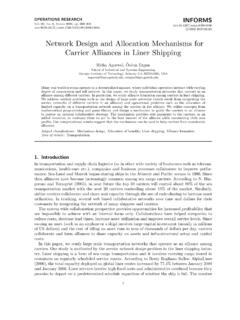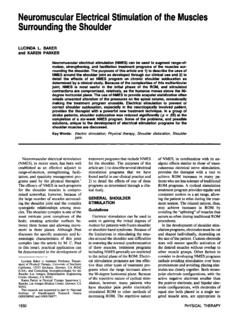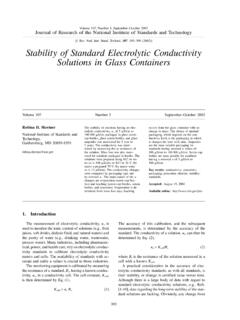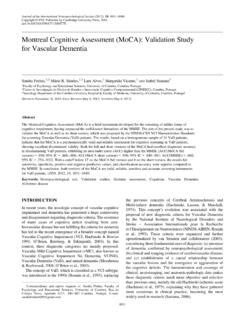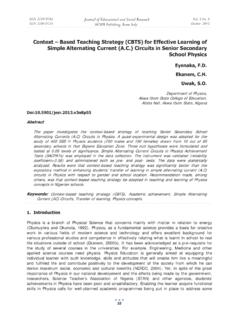Transcription of Optical sensors and their applications
1 Journal of Scientific Research and Reviews Vol. 1(5), pp. 060 - 068, November 2012. Available online at 2012 Wudpecker Research Journals ISSN 2277 0690. Review Optical sensors and their applications Dhiraj Ahuja and Deepa Parande M. Tech (EE) students, YMCA University of Science & Technology, Sector-6, Mathura Road, Faridabad Haryana-121. 0006, India. Accepted 15 September 2012. Optical sensors are used in numerous research, and commercial applications today. These sensors are used for quality and process control, medico technologies, metrology, imaging, and remote sensing to mention a few examples. Today there are many types of Optical sensors ; many based on the use of lasers, imaging systems, and/or fibers. In this article, development of devices to implement the various sensor types and their configuration into sensing elements are presented.
2 Some of the enabling technologies discussed include advances in short pulsed high power lasers, imaging methods, micro and nano-structured Optical sensing systems, and THz sensing. This article addresses various sensor types, and include all aspects of Optical sensors from the components employed, their configuration through detection schemes and algorithms, and application of sensors . Key words: Extrinsic sensors , intrinsic sensors , multiplexed sensor , distributed sensor , pressure sensor . INTRODUCTION. An Optical sensor is a device that converts light rays into imaging systems, and/or fibers. In addition, novel sensor electronic signals. Similar to a photo resistor, it measures methods that enable more advanced sensing are the physical quantity of light and translates it into a form continuously being developed by using novel materials, read by the instrument.
3 One of the features of an Optical such as meta materials, micro and nano structured sensor is its ability to measure the changes from one or materials or by employing new frequency bands as for more light beams. This change is most often based example THz radiation. around alterations to the intensity of the light. Optical sensors can work either on the single point method or through a distribution of points. Through the single point Advantages and disadvantages of Optical sensors method, a sole phase change is needed to activate the sensor . In terms of the distribution concept, the sensor is Research and development in the Optical sensor field is reactive along a long series of sensors or single fiber- motivated by the expectation that Optical sensors have optic array.
4 Significant advantages compared to conventional sensor Other features of Optical sensors include the distinction types, in terms of their properties. Below is given list of of whether it is placed internally or externally in a device. some of the advantages of Optical over non Optical The comparison of the two types is given in table 1. sensors . Today Optical sensors are used in numerous research, and commercial applications such as for quality and Greater sensitivity process control, medico technologies, metrology, Electrical Passiveness imaging, and remote sensing. There are many types of Freedom from Electromagnetic interference Optical sensors ; many based on the use of lasers, Wide dynamic range Both points and distributed configuration Multiplexing capabilities *Corresponding author E-mail: Taking advantage of the capacity of Optical fibers to send 61 J.
5 Sci. Res. Rev. Table 1. Comparison of Extrinsic and Intrinsic Optical sensors . Extrinsic Intrinsic applications - rotation, acceleration, applications - temperature, pressure, liquid level and flow. strain, acoustic pressure and vibration. Less sensitive More sensitive Easily multiplexed Tougher to multiplex Ingress/ egress connection problems Reduces connection problems Easier to use More elaborate signal demodulation Less expensive More expensive and receive Optical signals over long distances, a current by causing them to interact or interfere with one another. trend is to create networks of sensors , or sensor arrays. Thus sensors in this category are termed either intensity This avoids having to convert between electronics and sensors or interferometric sensors .
6 Techniques used in photonics separately at each sensing site, thereby the case of intensity sensors include light scattering (both reducing costs and increasing flexibility. A difficulty of all Rayleigh and Raman), spectral transmission changes sensors , both Optical and non Optical , is interference from ( , simple attenuation of transmitted light due to multiple effects. A sensor intended to measure strain or absorption), micro bending or radioactive losses, pressure may be very temperature-sensitive. reflectance changes, and changes in the modal properties of the fiber. Optical sensor technologies Extent of sensing Measurands and sensor categories This category is based on whether sensors operate only Through evolution of Optical sensing technology, one can at a single point or over a distribution of points.
7 Thus, measure nearly all of the physical measurands of interest sensors in this category are termed either point sensors and a very large number of chemical quantities. The or distributed sensors . In the case of a point sensor , the measurands possible are listed below: transducer may be at the end of a fiber. Examples of this sensor type are fiber Bragg gratings distributed along a Temperature fiber length to measure strain or temperature. Pressure Flow Liquid level Types of Optical sensors Displacement (Position). Vibration Optical sensor has two points. One is the transmitting Rotation point where light is emitted and the other end is the Magnetic fields receiving end. Generally there are 3 types of Optical Acceleration sensor , through beam, reflective and retro reflective.
8 Chemical species Each of this type has different advantages: Force Radiation Through Beam sensor Ph Humidity This sensor is suitable for absolute detection of solid Strain object. The transmitter and receiver are pointing to each Velocity other directly in order to create a straight light path. Electric fields Whenever there is any object which passes by the light Acoustic field transmission path, the amount of received light by the receiver will be zero or reduced and the sensing method is interrupting the light source received by the receiver Means of sensing (Figure 1 and Figure 2). In this category, sensors are generally based either on Reflective sensor : This type of sensor if suitable to measuring an intensity change in one or more light perform color differentiation.
9 The transmitter and receiver beams or on looking at phase changes in the light beams of this sensor are parallel to each other. The method of Ahuja and Parande 62. Figure 2. With object interupting the light path. Figure 1. Without object. listed below (Fidanboylu KA* and Efendioglu HS, 2009). a. Easy integration into a wide variety of structures, including composite materials, with little interference due detection is through reflection of light emitted by the to their small size and cylindrical geometry. receiver (Figure 3). b. Inability to conduct electric current. If we are to use reflective sensor , we should take note c. Immune to electromagnetic interference and radio that this sensor actually does detection base on quantity frequency interference.
10 Of light that is reflected back to the receiver. If the light d. Lightweight. source used is red LED, we will face problem to e. Robust, more resistant to harsh environments. differentiate red and white objects. Red and white f. High sensitivity. actually reflect back almost the same amount of light. g. Multiplexing capability to form sensing networks. Refer to the color differentiation chart below (Figure 4). h. Remote sensing capability. i. Multifunctional sensing capabilities such as strain, General advantages of Optical sensors pressure, corrosion, temperature and acoustic signals. 12. Techniques by which the measurements are made General advantages of Optical sensors are listed below: can be broadly grouped in three categories depending on (a) How the sensing is accomplished, 1.
